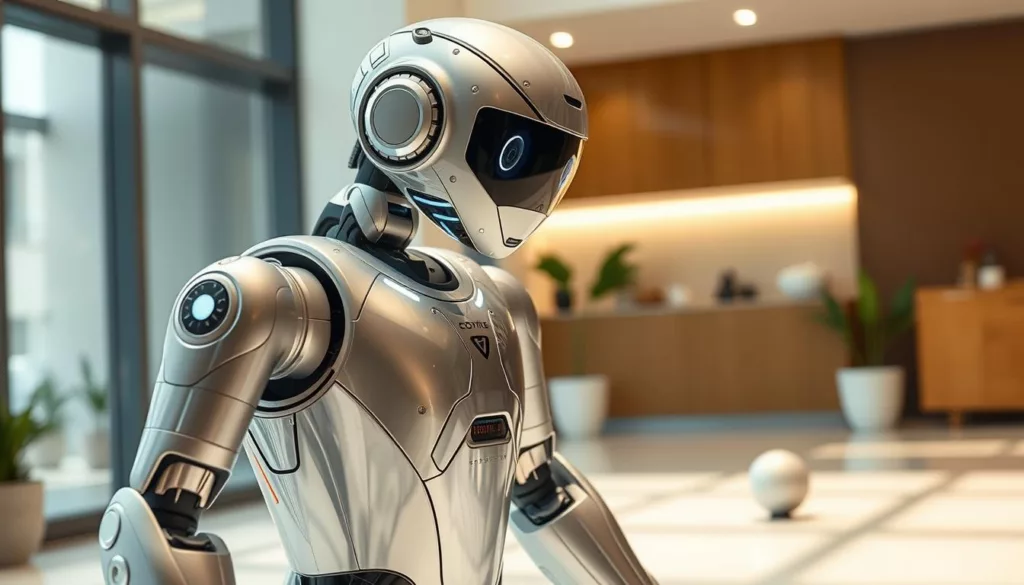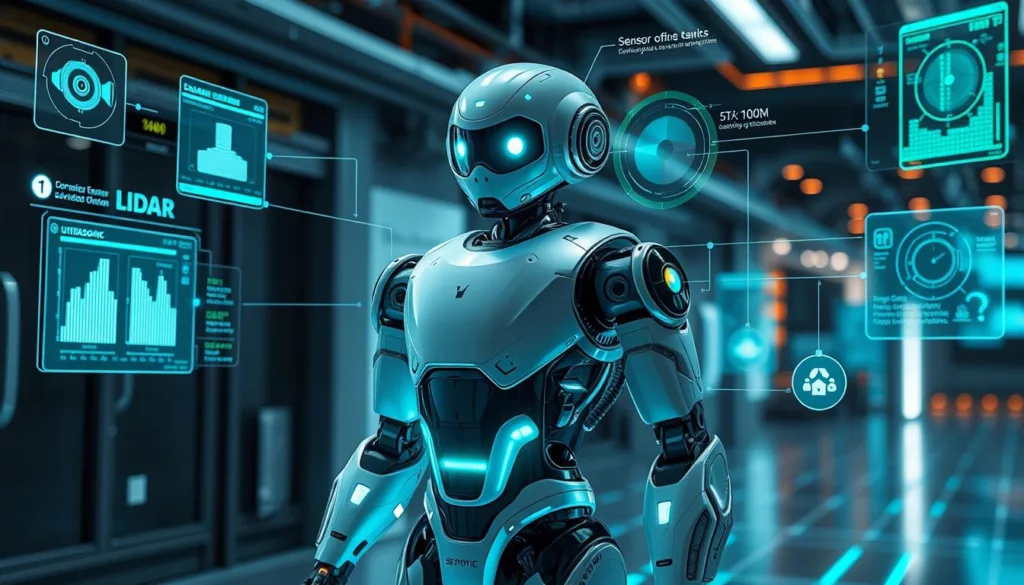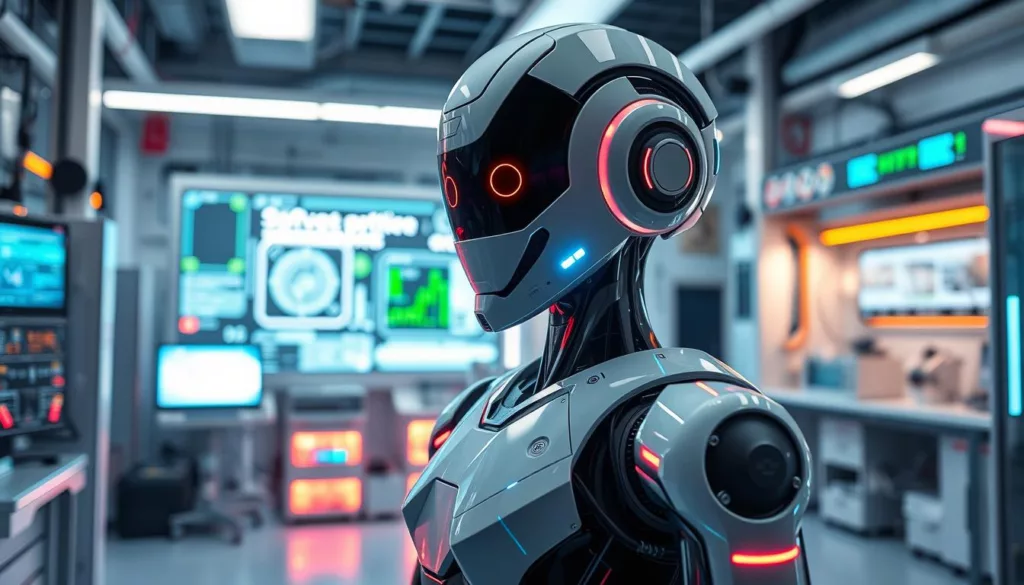The robotics world is growing fast, and so is the need for good sensor solutions. Service robots help us with many tasks and need smart sensors to see, move, and interact. At XJCSENSOR, we focus on top sensor tech to make service robots better at their jobs.
In this article, we’ll look at what makes sensor solutions reliable for service robots. We’ll talk about the sensors used, their uses, and the hurdles in using them. Our goal is to help experts and engineers choose the right sensors for their robots.
Key Takeaways
- Reliable sensor solutions are key for service robots to do better.
- Knowing the sensors like proximity, cameras, and LIDAR is important for good use.
- Good sensor solutions are precise, accurate, durable, and fit well with other systems.
- Sensors are used in many areas like healthcare, hospitality, and automation.
- Using sensors can be tricky because of environment, cost, and tech limits.
Introduction to Service Robots and Sensor Technology
In the fast-changing world of robotics, service robots are making big changes. They are changing many industries and making our lives better. At their core, they use sensor technology to see and interact with their world.
Definition of Service Robots
Service robots help humans with many tasks. They work in healthcare, hospitality, and more. They can move, sense, and act on their own, often without people watching.
Importance of Sensor Technology in Robotics
The success of service robot hardware depends on robot safety sensors and autonomous navigation sensors. These systems help robots see, avoid obstacles, and make smart choices. This ensures they work safely and well in complex places.
- Proximity sensors watch the robot’s area, helping it avoid crashes and move exactly.
- Vision systems, like cameras and algorithms, let robots see and react to things.
- LIDAR and other sensors help robots map and move around on their own.
By combining these sensors, service robots work with great precision and safety. They are very useful in many fields and tasks.
“Sensor technology is the backbone of service robotics, enabling these intelligent machines to perceive, analyze, and respond to their surroundings with unparalleled precision and agility.”
| Sensor Type | Key Function | Example Applications |
|---|---|---|
| Proximity Sensors | Detect and avoid obstacles | Collision prevention, precision maneuvering |
| Vision Systems | Provide visual perception and recognition | Object identification, facial recognition, gesture control |
| LIDAR Sensors | Enable autonomous navigation | 3D mapping, route planning, self-driving capabilities |
Types of Sensors Used in Service Robots
In the world of service robotics, many sensors are key. They help these smart machines see and interact with their world. From detecting obstacles to navigating, these sensors are vital.
Proximity Sensors
Proximity sensors are a must for service robots. They help these machines avoid hitting things. Using ultrasonic, infrared, or laser tech, they tell robots how far away objects are.
This info lets robots move safely and well in changing places. With human-robot interaction sensors, they can act with great care, making their work smooth.
Cameras and Vision Systems
Cameras and vision systems are key for service robots. They help with tasks like seeing objects, faces, and even gestures. Sensor fusion algorithms mix data from different cameras and sensors.
This gives robots a clear view of their world. It’s super useful in places like hospitals, where robots need to move around and talk to people.
LIDAR and Navigation Sensors
For service robots, knowing where they are is important. Industrial robotics sensors like LIDAR help a lot. LIDAR uses lasers to make 3D maps of the area.
This lets robots find their way and plan paths. With LIDAR and other sensors, robots can move through tough spots and work well.
Putting all these sensors together is what makes service robots work so well. Sensor fusion algorithms help them make smart choices and adapt to new situations. This makes them reliable helpers in many areas.
Key Features of Reliable Sensor Solutions
Service robots rely heavily on their sensors. These sensors act as the robots’ eyes and ears. They provide vital data for navigation, object detection, and interaction with the environment. Let’s look at what makes sensor solutions reliable for service robots.
Precision and Accuracy
The success of a service robot depends on its sensor readings. Whether it’s measuring distance or detecting faces, the data must be precise. Reliable sensors ensure the robot can accurately respond to its surroundings.
Durability and Longevity
Service robots face tough environments. They are exposed to physical stress, temperature changes, and contaminants. Reliable sensors are built to last, providing consistent performance over time. They use strong materials and advanced sealing to keep working well, even in harsh conditions.
Integration with Existing Systems
It’s key for sensors to work well with a robot’s control and navigation systems. They must communicate effectively with the robot’s processors. Reliable sensors are designed to integrate smoothly, making the robot more adaptable and responsive.
By focusing on precision, durability, and integration, reliable sensor solutions are vital. They help service robots perform tasks accurately and efficiently. These features are key for unlocking the full power of mobile robot sensors in various fields, from healthcare to industrial automation.
Applications of Sensor Solutions in Service Robots
Sensor technologies have changed how service robots work. They can now handle many tasks in different fields. From helping in healthcare to working in hotels and factories, these robots are making a big difference.
Healthcare and Medical Assistance
In healthcare, service robots with robotic perception and autonomous navigation sensors are very helpful. They help doctors and nurses by watching over patients, bringing medicine, and even chatting with them. Their smart sensors and algorithms let them move around hospitals safely and give care that fits each patient’s needs.
Hospitality and Customer Service
The hospitality world has also seen service robots with industrial robotics sensors. These robots make staying in hotels better by saying hello, bringing food, and helping guests. They can move through busy areas, understand voice commands, and even guess what guests like to make their service more personal.
Industrial and Warehouse Automation
In factories and warehouses, sensor robots are making things more efficient. They have many robotic perception and autonomous navigation sensors to move around, find items, and work with other systems. This has made tracking inventory, filling orders, and running operations better.
Service robots with sensors are very useful in many areas. As technology gets better, we’ll see even more ways these robots help us in the future.
Challenges in Implementing Sensor Solutions
Sensor integration is key for service robots to work well. But, there are big challenges to overcome. Things like environment, cost, and technical limits affect how well robot safety sensors and human-robot interaction sensors work.
Environmental Factors
Service robots face many environments. Temperature, humidity, dust, and vibrations can mess with sensor data. It’s important to make sensors that can handle these issues well.
Cost Considerations
High-tech sensors, like those for human-robot interaction, are pricey. Adding these to robots can make the whole system more expensive. Finding a balance between cost and quality is hard for developers.
Technical Limitations
Putting sensors together and processing data can be tough. Robots need to handle many sensors at once and make decisions fast. Overcoming these tech hurdles is key for better sensor integration in robots.
| Challenge | Description | Potential Solutions |
|---|---|---|
| Environmental Factors | Extreme temperatures, humidity, dust, and vibrations can impact sensor performance. | Develop ruggedized, weatherproof sensor designs; Implement advanced sensor data fusion algorithms to enhance reliability. |
| Cost Considerations | High-precision, durable sensors can be expensive, increasing the overall system cost. | Explore cost-effective sensor alternatives; Leverage economies of scale through standardized sensor platforms. |
| Technical Limitations | Integrating multiple sensor modalities and real-time data processing can strain computational resources. | Optimize sensor data management and processing algorithms; Utilize edge computing and cloud-based processing solutions. |
By tackling these challenges, developers can make service robots better. They can improve sensor integration, robot safety sensors, and human-robot interaction sensors. This leads to more reliable and affordable robots for many uses.
Leading Companies in Sensor Technology for Service Robots
The robotics world is growing fast, and good sensors are key for service robots. ABB Robotics, Clearpath Robotics, and SICK AG are leading this charge. They’re making big steps in sensor tech for robots, opening up new uses in many fields.
ABB Robotics
ABB Robotics is a big name in making things work better. They offer a wide range of sensors for service robots. These help robots work better, see clearer, and move around easily.
ABB’s sensors work well with their robot systems. This lets service robots handle tough tasks and move through complex spaces.
Clearpath Robotics
Clearpath Robotics is a Canadian company making waves in sensor tech. They focus on robots that can move on their own. Their sensors help these robots see and avoid things, making them great for many jobs.
Clearpath’s sensors include LIDAR, cameras, and special algorithms. These are used in many areas, like healthcare and delivery.
SICK AG
SICK AG is a German company known for its sensor tech. They make sensors that are tough, accurate, and easy to use. Their sensors are key for robots to work safely and reliably.
SICK’s sensors include proximity, vision, and safety systems. They’re a go-to for robot makers around the world.
These top companies are making service robots better and more useful. ABB Robotics, Clearpath Robotics, and SICK AG are leading the way. Their work will help service robots grow and improve in many areas.
Future Trends in Sensor Technology for Service Robots
The service robotics field is growing fast, with advanced sensors playing a key role. Sensor fusion algorithms are becoming more common. They mix data from different sensors to boost robotic perception and autonomous navigation sensors. This use of artificial intelligence (AI) and machine learning helps robots make better decisions.
Also, sensors are getting smaller and lighter. This makes it easier to fit them into service robots. They can move better, reach more places, and work in different settings. This miniaturization is leading to new uses in healthcare, hospitality, and industry.
There’s also a big push for better data processing and analysis. New algorithms and faster computers let robots understand sensor data quickly. This means they can do tasks better, stay safe, and work well with people.
“The future of service robotics lies in the seamless integration of advanced sensor technologies, empowering these machines to perceive, navigate, and interact with their surroundings with unparalleled precision and adaptability.”
As service robotics keeps growing, these advanced sensors will be key. They will open up new possibilities and help create smarter, more useful robots.
Case Studies: Successful Implementations
Service robots are becoming more common, and it’s key to know how sensors help them work well. We’ll look at two examples that show how sensors make a difference in different settings.
Use Case in Hospital Settings
In a top hospital, service robots with human-robot interaction sensors help out. They use mobile robot sensors to move around and service robot hardware to do tasks like bringing meds and supplies. They even keep patients company. The hospital says staff work better and patients are happier with these robots.
“The sensors on our service robots have been a game-changer, allowing us to streamline operations and free up our staff to focus on direct patient care. We’ve seen a noticeable reduction in medication delivery times and an increase in patient engagement.”
Use Case in Retail Environments
In a big retail store, robots with human-robot interaction sensors help customers and keep stock right. They use service robot hardware and mobile robot sensors to find what’s needed and talk to shoppers. The store is happier with its customers and keeps stock better with these robots.
These examples show how sensors help service robots in various fields. By using the latest in human-robot interaction sensors, service robot hardware, and mobile robot sensors, places can get better at serving customers and running smoothly.
Conclusion: The Future of Reliable Sensor Solutions
Reliable sensor solutions are key for service robots to move, see, and interact with their world. They use advanced sensors like proximity, vision, and LIDAR. This has made service robots better at many tasks in healthcare, hospitality, and industry.
Summary of Benefits
These solutions bring many benefits. They help service robots gather accurate data, making them work better and faster. They also last long, working well even in tough conditions. Plus, they fit easily with other systems, making them very useful in many fields.
Call to Action for Industry Stakeholders
As more people want service robots, it’s important for everyone involved to use reliable sensors. Investing in new sensor tech and innovation will help businesses stay ahead. The future of service robots looks bright, and those who use reliable sensors will do well.






